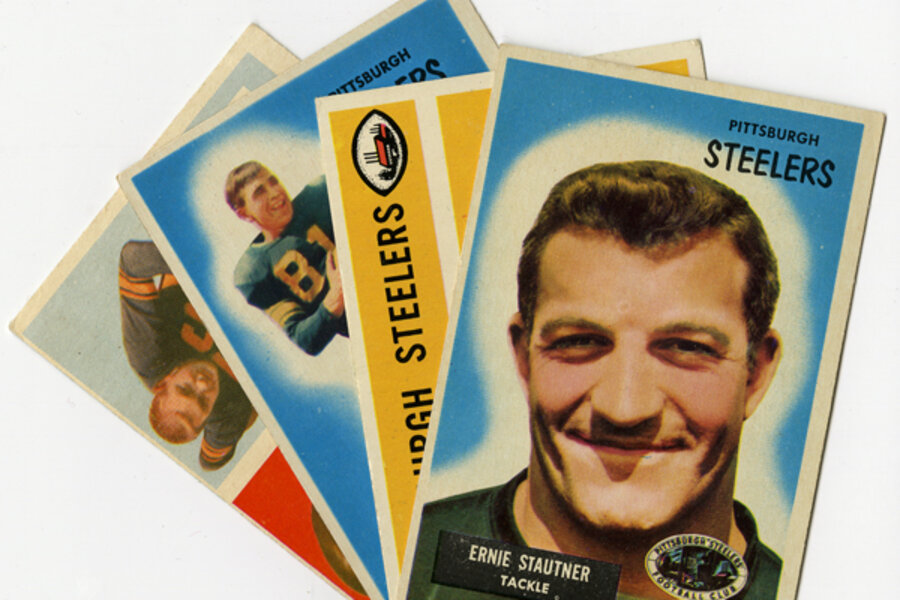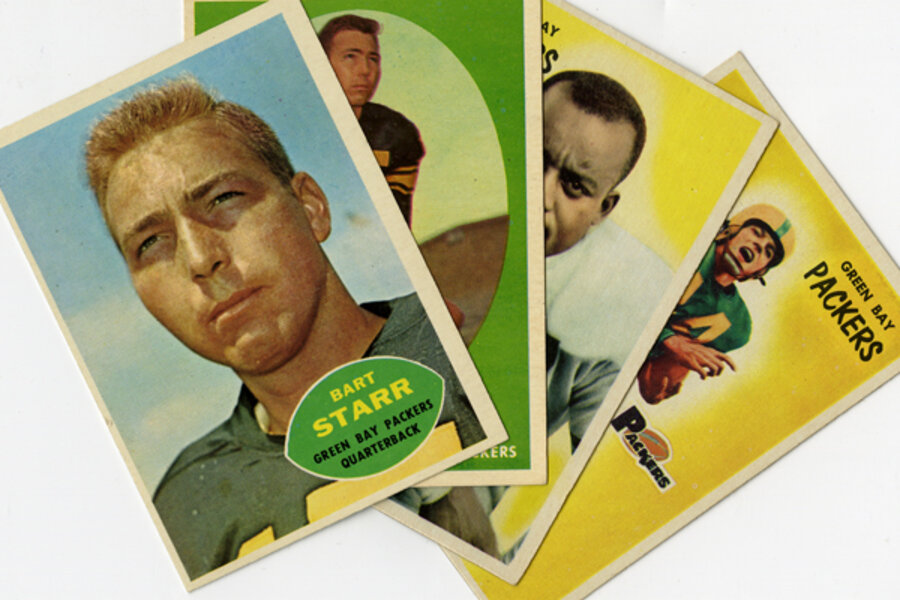Super Bowl 2011: My life with the Pittsburgh Steelers and Green Bay Packers
Loading...
For the sake of full disclosure, let me say right up front that I have never worked for, played on, or been an insider of any variety with either of this Sunday’s Super Bowl teams.
My “life” with the Steelers and Packers, as it were, is more fleeting and distant than that, but maybe other baby boomers like myself, who grew up in the 1950s and 1960s, can relate to some of the experiences shared here.
It all began in the late 1950s when I was first introduced to the National Football League. The telecast of the 1958 championship game, won dramatically in sudden death by the Baltimore Colts in Yankee Stadium, was not only a seminal moment for the league, it was the starting point for my interest in pro football – and apparently for millions of other Americans.
The game has often been described as the greatest in NFL history because of the way it captured TV viewers and made pro football, not baseball, the sport of the TV age.
Of course there weren’t many games on the tube even after this landmark telecast, so to bridge those one-game-a-week, black-and-white Sunday broadcasts, boys like myself turned to a pioneering weekly magazine, Sports Illustrated, and bubblegum trading cards.
The latter, for the first time, really brought me face to face with members of the Steelers and Packers. Neither team in the late 1950s was very good, but for a youngster, there was still a fascination with anyone immortalized on cardboard. It didn’t matter whether they were lesser-known Packers such as Veryl Switzer and Roger Zatkoff and journeymen Steelers Fran Rogel and Elbert Nickel, or more prominent players on these teams: Bart Starr, Jim Ringo, Max McGee with the Packers, and Ernie Stautner, Bobby Layne, and John Henry Johnson with the Steelers.
The team that really hooked me were the Chicago Bears, whose games were regular TV fare in Evansville, my southern Indiana hometown. This was when the Bears played at Wrigley Field, George Halas was the coach, and the broadcast team consisted of two former Bear greats, Red Grange, the man known as the Galloping Ghost, and George Connor.
From rooting for the Bears, I gained my first real acquaintance with the Packers, who emerged as the league’s dominant power under Vince Lombardi and served as Chicago’s perennial nemesis. The Green Bay players became household names and regular foils for the Bears in twice-a-season games.
The Steelers, on the other hand, remained a mystery to me. They played in the NFL’s East Conference, and I never once remember the Bears squaring off with them on television.
My in-person spectating of any of these teams was limited to two brief visits to the Bears’ summer training camp, then held in the sleepy town of Rensselaer, Ind. That is until 1963, when on a family vacation to Chicago, we secured tickets to the annual College All-Star Game at Soldier Field. The defending NFL champs took on the best college seniors from the previous year in the preseason event begun in 1934.
The pros almost always won, and the Packers, at the peak of their powers in 1963, seemed virtually certain to teach the college stars a few lessons. But lo and behold, in a shocking upset, a college squad led by quarterback Ron Vander Kelen, who played right under the Packers’ noses at the University of Wisconsin, toppled the two-time defending NFL champions, 20-17. It was the last time the pros ever lost in the annual showdown, which was terminated after Pittsburgh crushed the college stars, 24-0, in 1976.
Vander Kelen had also been the hero for Wisconsin in the 1963 Rose Bowl, even though the Badgers ultimately lost to Southern Cal, 42-37, after mounting the greatest comeback in the game’s history. Wisconsin scored 23 unanswered points in the fourth quarter in a first-ever bowl match-up of No. 1 and No. 2 ranked teams.
Ironically, Vander Kelen had a short, undistinguished NFL career.
While the Packers emerged as a power under Lombardi, the Steelers continued to fly under the NFL radar during most of the sixties, hitting rock bottom in 1969 with a 1-13 record.
It was in the aftermath of that debacle, while reading a sports magazine at an off-campus laundromat in Bloomington, Ind., that I first learned of quarterback Terry Bradshaw, the designated savior of the woeful Steelers. With the NFL’s No. 1 overall draft pick, Pittsburgh had selected Bradshaw out of Louisiana Tech.
After decades of futility, Bradshaw and the vaunted Steel Curtain defense managed to win the franchise’s first playoff game in 1972 and won their first Super Bowl, with a 16-6 victory over the Minnesota Vikings, two seasons later.
I watched that one on TV, but had the good fortune as a sportswriter for The Christian Science Monitor, to be assigned to cover Super Bowl XIII, maybe the most exciting in the game’s first 30 years. It pitted the Steelers against the other team vying for preeminence in the ‘70s, the Dallas Cowboys. Pittsburgh was built to appeal to the blue-collar crowd, Dallas to football progressives in a gleaming Texas boomtown.
The Super Bowl was played in the aging Orange Bowl, with the clouds clearing, as if on cue, after a torrential pregame downpour. During a first half played in brilliant sunshine and a second half after nightfall, the two teams traded scores, with Pittsburgh’s Lynn Swann hauling in what proved to be the winning touchdown pass from Bradshaw midway through the fourth quarter. Final score: Steelers 35, Cowboys 31.
As you might imagine, I’ve kept my press pass for that storied Steelers’ game.
As for the Packers, I still keep the audiotape of Packer quarterback Bart Starr that I recorded during a 1997 media teleconference to mark the 30th anniversary of the coldest NFL game in history, the famous “Ice Bowl.” With the temperature 13 below zero and the wind chill -48, Starr tucked himself in behind guard Jerry Kramer on a sneak with 13 seconds left that gave Green Bay a 21-17 victory over Dallas in the NFL championship game.
The game, of course, was in Green Bay, but I saw it on TV in an El Segundo, Calif., motel room, where I joined hundreds of other Indiana University students on the school’s first and only trip to the Rose Bowl. That, however, is a story for another day.






